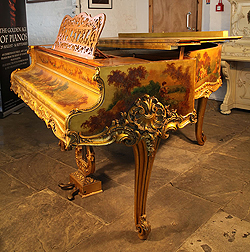
Rococo, less commonly Roccoco or Late Baroque, is an exceptionally ornamental and theatrical style of architecture, art and decoration which combines asymmetry, scrolling curves, gilding, white and pastel colors, sculpted molding, and trompe l'oeil frescoes to create surprise and the illusion of motion and drama. It is often described as the final expression of the Baroque movement.
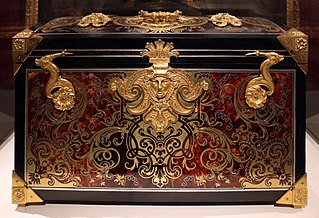
Marquetry is the art and craft of applying pieces of veneer to a structure to form decorative patterns, designs or pictures. The technique may be applied to case furniture or even seat furniture, to decorative small objects with smooth, veneerable surfaces or to freestanding pictorial panels appreciated in their own right.
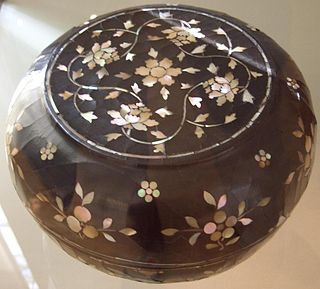
The term lacquer is used for a number of hard and potentially shiny finishes applied to materials such as wood or metal. These fall into a number of very different groups.

Grisaille is a painting executed entirely in shades of grey or of another neutral greyish colour. It is particularly used in large decorative schemes in imitation of sculpture. Many grisailles include a slightly wider colour range, like the Andrea del Sarto fresco illustrated. Paintings executed in brown are referred to as brunaille, and paintings executed in green are called verdaille.

Japanning is a type of finish that originated as a European imitation of Asian lacquerwork. It was first used on furniture, but was later much used on small items in metal. The word originated in the 17th century. American work is more often called toleware.

Kakiemon is a style of Japanese porcelain, with overglaze decoration called "enameled" ceramics. It was originally produced at the factories around Arita, in Japan's Hizen province from the Edo period's mid-17th century onwards. The style shares much in common with the Chinese "Famille Verte" style. The quality of its decoration was highly prized in the West and widely imitated by major European porcelain manufacturers during the Rococo period.

Rocaille was a French style of exuberant decoration, with an abundance of curves, counter-curves, undulations and elements modeled on nature, that appeared in furniture and interior decoration during the early reign of Louis XV of France. It was a reaction against the heaviness and formality of the Style Louis XIV. It began in about 1710, reached its peak in the 1730s, and came to an end in the late 1750s, replaced by Neoclassicism. It was the beginning of the French Baroque movement in furniture and design, and also marked the beginning of the Rococo movement, which spread to Italy, Bavaria and Austria by the mid-18th century.

The Style Louis XV or Louis Quinze is a style of architecture and decorative arts which appeared during the reign of Louis XV. From 1710 until about 1730, a period known as the Régence, it was largely an extension of the Style Louis XIV of his great-grandfather and predecessor, Louis XIV. From about 1730 until about 1750, it became more original, decorative and exuberant, in what was known as the Rocaille style, under the influence of the King's mistress, Madame de Pompadour. It marked the beginning of the European Rococo movement. From 1750 until the King's death in 1774, it became more sober, ordered, and began to show the influences of Neoclassicism.
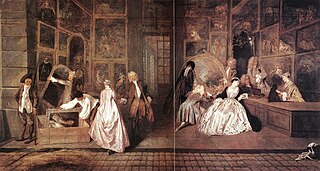
A marchand-mercier is a French term for a type of entrepreneur working outside the guild system of craftsmen but carefully constrained by the regulations of a corporation under rules codified in 1613. The reduplicative term literally means a merchant of merchandise, but in the 18th century took the connotation of a merchant of objets d'art. Earliest references to this Corps de la Ville de Paris can be found at the close of the 16th century, but in the 18th century marchands-merciers were shopkeepers but they also played an important role in the decoration of Paris homes. In fact, they served as general contractors, designing and commissioning pieces of the most fashionable furniture, and often, in addition, worked outside of their shops as interior decorators, responsible for many aspects of a room's decor. In Paris, the guild system, in place since the late Middle Ages, prohibited craftsmen from working with any material with which they had not undergone a formal apprenticeship. Only a marchand-mercier who worked outside of the guild system, therefore, could mount Chinese porcelains with gilt-bronze handles and stands, fit the cabinetmaker's furniture with Japanese lacquer or Sèvres porcelain plaques, and supply furniture with opulent gilt-bronze mounts.

Limoges porcelain is hard-paste porcelain produced by factories in and around the city of Limoges, France beginning in the late 18th century, but does not refer to a particular manufacturer. By about 1830 Limoges, which was close to the areas where suitable clay was found, had replaced Paris as the main centre for private porcelain factories, although the state-owned Sèvres porcelain near Paris remained dominant at the very top of the market. Limoges has maintained this position to the present day.
Ébéniste is a loanword for a cabinet-maker, particularly one who works in ebony.

Roger Vandercruse Lacroix (1728–1799), often known as Roger Vandercruse, was a Parisian ébéniste whose highly refined furniture spans the rococo and the early neoclassical styles. According to Salverte, he "is counted among the great ebenistes of his generation ."

Martin Carlin was a Parisian ébéniste (cabinet-maker), born at Freiburg, who was received as Master Ébéniste at Paris on 30 July 1766. Renowned for his "graceful furniture mounted with Sèvres porcelain", Carlin fed into the luxury market of eighteenth-century decorative arts, where porcelain-fitted furniture was considered among "the most exquisite furnishings" within the transitional and neoclassical styles. Carlin's furniture was popular amongst the main great dealers, including Poirier, Daguerre, and Darnault, who sold his furniture to Marie Antoinette and many amongst the social elite class. He died on 6 March 1785.

Jean Dunand (1877–1942) was a Swiss and French painter, sculptor, metal craftsman and interior designer during the Art Deco period. He was particularly known for his lacquered screens and other art objects.

Cizhou ware or Tz'u-chou ware is a term for a wide range of Chinese ceramics from between the late Tang dynasty and the early Ming dynasty, but especially associated with the Northern Song to Yuan period in the 11–14th century. It has been increasingly realized that a very large number of sites in northern China produced these wares, and their decoration is very variable, but most characteristically uses black and white, in a variety of techniques. For this reason Cizhou-type is often preferred as a general term. All are stoneware in Western terms, and "high-fired" or porcelain in Chinese terms. They were less high-status than other types such as celadons and Jun ware, and are regarded as "popular", though many are finely and carefully decorated.

Chantilly porcelain is French soft-paste porcelain produced between 1730 and 1800 by the manufactory of Chantilly in Oise, France. The wares are usually divided into three periods, 1730-51, 1751-1760, and a gradual decline from 1760 to 1800.
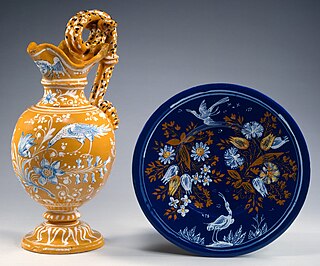
The city of Nevers, Nièvre, now in the Bourgogne-Franche-Comté region in central France, was a centre for manufacturing faience, or tin-glazed earthenware pottery, between around 1580 and the early 19th century. Production then gradually died down to a single factory, before a revival in the 1880s. In 2017, there were still two potteries making it in the city, after a third had closed. However the quality and prestige of the wares has gradually declined, from a fashionable luxury product for the court, to a traditional regional speciality using styles derived from the past.

French porcelain has a history spanning a period from the 17th century to the present. The French were heavily involved in the early European efforts to discover the secrets of making the hard-paste porcelain known from Chinese and Japanese export porcelain. They succeeded in developing soft-paste porcelain, but Meissen porcelain was the first to make true hard-paste, around 1710, and the French took over 50 years to catch up with Meissen and the other German factories.

Pierre Macret (1727–1796) was a well-known Parisian cabinetmaker (ébéniste). At the death of the widow of Jean-Pierre Latz in December 1756, he received Latz' court warrant as marchand-ébéniste privilégié du Roi suivant la Cour,, a brevet that exempted him from the stringent regulations of the Paris guild. In 1758 he was belatedly admitted maître-ébéniste by the guild, which henceforth required him to stamp his production. Numerous pieces bearing Macret's poinçon survive.

Mathieu Criaerd (1689–1776) was the most prominent of a large family of cabinetmakers (ébénistes), apparently of Flemish ancestry, who were working in Paris during the 18th century. He became a master in the Corporation des Menuisiers-Ébénistes 29 July 1738 and set up his workshop in the rue Traversière-Saint-Antoine, in the heart of the furniture-making district of Paris, using the stamp M CRIAERD.

